Amber Meyer was the South African Institute of Industrial Engineering’s Best Final Year NDip student in 2019, yet she never thought she would graduate, twice in a row or cum laude, having had to overcome educational and financial hurdles.
This year she is graduating with her BTech in Industrial Engineering also cum laude at the Autumn Graduation. "I cannot believe it".
The first two graduates in BEngTech Marine Engineering graduated at Nelson Mandela University’s Autumn Graduation.
Matthew Nel and Aidan August are furthering their studies and have enrolled for the 4th year honours in Mechanical Engineering at the University, taking selective specialist modules in marine engineering focusing on ship and marine craft design.
An Autonomous Solar Boat prototype that was designed in Nelson Mandela Bay will soon have its maiden voyage at sea.
The boat is a pilot project of the South African International Maritime Institute (SAIMI)-funded Marine Robotics Centre based at Nelson Mandela University. SAIMI promotes these and other innovative projects to increase technological advancements in the maritime sector through the support of the National Skills Fund (NSF).
In this professorial inaugural lecture Professor of Mechanical Engineering at Mandela University, Russell Phillips, unpacked the role of renewable energy in de-urbanising post-COVID Africa.
In his lecture, delivered virtually on 28 June 2021, Prof Phillips spoke of how the world is becoming increasingly urbanised with more than half of its population living in cities.
Nelson Mandela University has opened up a second vaccination site, specifically dedicated to its 29 000 students.
North Campus
The new site at the Student Health Services clinic on North Campus and close to the COVID-19 Vaccination Centre, which is presently serving both staff and the public, opens tomorrow (Monday, 19 July).
Reasons to be Proud - #R2bP: The Advanced Engineering Design Group’s (AEDG) engineering students are in an exciting collaborative project with well-known racing team, Scuderia Scribante.
Their project is to categorise the aero profile of their two Lamborghini Huracan GT racing cars, which compete in the newly established and internationally-compatible South African National GT Championship.
Mechanical Engineering student, Wian van Aswegen from Port Alfred, has designed and created a unique 3D metal printed golf putter.
Congratulations to Dr Mabila Mthebula who has been invited to the Advisory Body as a Hon'ble Advisory Committee Member of the council in India.
Reasons to be Proud - #R2bP: Representing South Africa, Nelson Mandela University students Randolph Meth and Kwanda Jakalase will receive resources and mentorship for developing their visionary idea to make an impact on campus and beyond.
Collaboration between the sciences and the social sciences can only lead to the improvement of sustainable and renewable energy, the effects of climate change on the environment, food security and the alleviation of poverty.
In this case, engineers as scientists are solving technical challenges contributing to social benefits.
This message was shared at the webinar Conversation 3: The Sciences in Service of Society hosted by Nelson Mandela University’s Engagement and Transformation Portfolio – Hubs of Convergence. The School of Engineering’s Professor Russell Phillips, Karl du Preez and lab intern Kabelo Mpurwana as well as guesthouse owner at Riemvasmaak, Elisa Namases, were the presenters.
Riemvasmaak in the Northern Cape is about 20 km east of the Namibian border and has the highest solar energy in the country with temperatures reaching 50 degrees Celsius in summer. The arid desert landscape receives less than 50mm of rainfall annually.
This is where, for a number of years, Mandela University’s School of Engineering has performed solar and wind energy research, benefiting a small farm, a guesthouse and the community, as well as many students who not only learnt by doing the practical work but also realised their value to the community.
The project started with Prof Phillips’s passion for de-urbanisation as a solution to not only the effects of climate change, but also alleviating poverty. “I firmly believe that people should live outside the cities, de-urbanise and for that, they need energy, connectivity and effective ways to run small farms. This means spending time with communities to find out what their needs are and discuss the best possible solutions with short term initiatives. We take our knowledge for granted, but how do we as engineers contribute to job creation and agriculture as a business, which is at the forefront of this project?” he says.
The Riemvasmaak project is run by the School of Engineering’s Advanced Mechatronic Technology Centre (AMTC) and is funded by merSETA (the Manufacturing, Engineering and Related Services SETA). The AMTC has been in existence for the past 18 years and is currently involved with drone projects and short courses, the marine engineering degree and the Stem in Action schools science project, among others.
Initially, the Namases family used a petrol pump to get water from the river for household use on their family farm and often had to carry the water a long distance. From there, the idea was born to run a solar pump to save them money and to have a sustainable energy source.
Since the first project - setting up a solar pump - the farm has grown to boast a viable guesthouse and an extensive vegetable garden, from melons to beetroot and carrots, which not only supplies the Namases family, but also the elderly nearby.
In 2020, the first live research site was established on the farm, feeding research data to the University and the guesthouse. Owner Ms Elisa Namases, who grew up on the farm, signed a formal Memorandum of Understanding with the University. A second set of solar panels was installed as well as two wind turbines to assist in supplying electricity to the guesthouse and to pump water.
“They know the best solutions and we can listen to them. I am, for example, working on a kit for a solar pump for communities to build their own water pump. We as engineers, have to venture out of our silos to solve pressing societal issues and add value. My greatest takeaway from this, my biggest project, is the satisfaction of building something that changes someone’s life. Although the extreme heat was challenging, it was satisfying to see an idea become a reality. We can start at home with small projects making a big difference, Kabelo said.
“I will never forget our emotions when the first water was pumped out of the river. This research project also grows our students. The project demanded hard physical labour for days, which we as staff and students performed together both in our labs and on site. Kabelo worked through lockdown on this project,” said Mr Du Preez.
“It is difficult to involve academics in these projects as we all have a fulltime workload as lecturers and projects need funding. One has to build on your relationship with funders, then funding is more easily available for sustainable projects. In this case, it is a viable system which has been running for a number of years.
Hubs of Convergence’s Dr Bruce Damons mentioned the advantage of tapping into Ms Namases’ indigenous knowledge, shown on a short video. For example, she knows exactly what will grow in the arid conditions, yet fertile soil. The knowledge exchange for researchers and students is extremely valuable and similar projects should also be looked for in the Eastern Cape.
Dr Ossie Franks from the Strategic Resource Mobilisation and Advancement Office, encouraged suggestions for the future including to involve other departments, for example, the University’s Agriculture department to assist the farm and expose students to the environment.
Prof Phillips mentioned a doctoral project in the Engineering School, also working on a solar-powered agricultural vehicle doing weeding, picking and other functions on a small-scale farm.
More people should be informed of the reciprocal benefits for society, staff and students that research can play and the University’s Hubs of Convergence emphasise this work in service of society. The importance of knowledge sharing and application through various mediums was also emphasised to extend the impact of the engagement and research, and to further sow seeds for further inter and transdisciplinary collaboration with multiple communities (stakeholders).
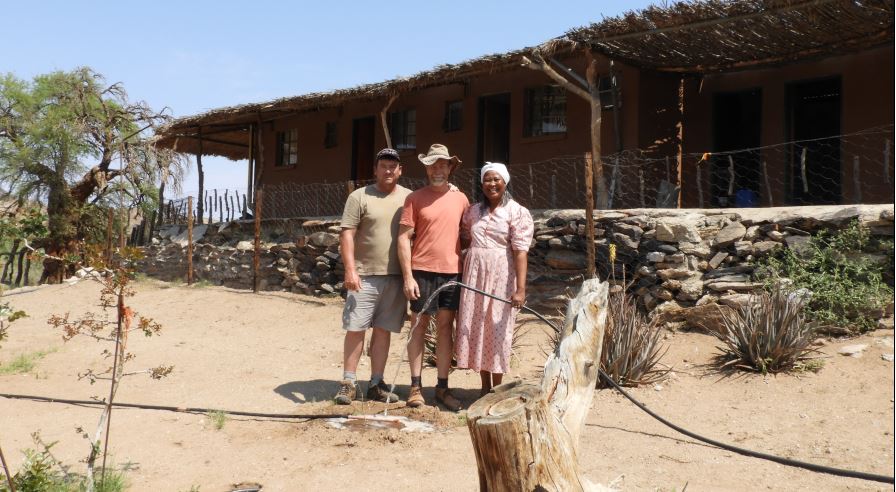
Engineering students and academics from Nelson Mandela University and the University of KwaZulu-Natal (UKZN) represented South Africa in the 2020 Global Cybathlon Championship hosted by Switzerland last weekend.
The Team, with the support of the Robotics Association of South Africa, were the only participants selected from Africa.
The Cybathlon is a unique, international multisport event with 60 teams from 20 countries taking part. The championship in which people with physical disabilities compete against each other to complete everyday tasks using state-of-the-art technical assistance systems is beyond just a competition – it also offers a platform to advance research in the field of assistive technology and to promote dialogue with the public about the inclusion of people with disabilities in everyday life.
Our Touch Hand team finished 11th out of 13 international competitors in their section, which featured mainly research and private sector entries. Sadly, a faulty tin can opener, supplied by the organisers deprived them of ending in the top 9. "Anything above that would have been beyond their reach with their current iteration as a massive funding injection as well as years of experience would be required" said Clive Hands from the Advanced Engineering Design Group (AEDG) in Mandela University’s School of Engineering.
The team finished above both the UK and Germany and the media attention gained was extremely encouraging. “Our students did us proud” said Clive.
The Damas guesthouse in the remote Riemvasmaak area in the Northern Cape, which received its first off-grid facility from Nelson Mandela University two years ago, now boasts a larger pumping system as well as an off-grid power supply system for lighting.
The first 1kW portable solar pumping station, developed by the University’s Renewable Energy Research Group (RERG), in collaboration with the merSETA (Manufacturing, Engineering, and Related Services Sector Education and Training), was designed to supply the guesthouse as well as Elisa Namases’ home with enough water for domestic use, which included the irrigation of two small vegetable gardens.
According to RERG’s Prof Russell Phillips, the pumping station was fitted with a remote telemetry system which allowed the University’s researchers to monitor its performance.
“This pumping station is responsible for much of the greenery around the guesthouse as well as maintaining the vegetable gardens, which are a primary source of food for Ms Namases, her extended family, and many of the elderly in the surrounding local community.
“Prior to the installation of the first pumping station in 2018, the family physically carried water from the river for their needs. Based on the success of the initial pumping installation, the University’s Advanced Mechatronic Technology Centre sought funding from MerSeta for a larger system. This was approved and the installation was completed by the University team in the latter part of September 2020“.
The maximum energy demand for lighting for the guesthouse was calculated to be 1.26 kWh per day. To meet this demand, a 1kWp PV solar array was installed to charge two 100 Ah deep cycle batteries. To supplement the solar array in charging the batteries, two wind turbines were added. An off-the-shelf horizontal axis wind turbine (HAWT), the ReGen 400W, and an Mandela University RERG designed custom-built helical savonius vertical axis wind turbine (VAWT) turning a 500W Ginlong generator.
“While the area has a low annual average wind speed, it was noted that particularly in summer, the region experienced brief, strong nocturnal winds that are expected to supplement battery charging significantly and ensure 24/7 availability of lighting for the Namases’ household and guest house.”
Prof Phillips says the primary aim of this project was to provide off-grid power for pumping and lighting to the Damas Guesthouse and a high DNI research test site for the University via a mutually beneficial formal agreement between the family and the University.
According to him, there are numerous secondary spin-off benefits. These include adequate energy and water to allow the family to be self-sufficient, improved quality of life for the family, a research test site for the University with low-cost overheads as well as the transfer of technical and farming skills to the local community with a view to additional similar projects in the region.
As part of the ongoing project, a second research site is located in the Riemvasmaak area earmarked for the solar pump array as well as future Mandela University research projects. The site is roughly 150m from the river, while the hectare of land to be irrigated is approximately 370m from the river.
Phillips says for the University, the next phase of this project is to enclose Research Site 2 which will be used as a storage facility for future projects.
“A communication link between our North Campus in Port Elizabeth and Research Site 2 will also be installed to monitor and receive live data from tests being conducted.”
Reasons to be Proud - #R2bP: In a first of its kind, the biennial international BRICS* Skills Challenge 2020 took place in a virtual online format, and Mandela University student Jacques Welgemoed (23) was part of the experience.
The master’s in Mechatronics student Welgemoed, mentored by Damian Mooney, represented South Africa in the challenge and achieved joint second place with the Temasek Polytechnic of Singapore taking top honours.
This year, 85 participants from 12 countries took part in a seven-day Drone Operating camp and challenge hosted by Copter Ex of Moscow, Russia.
Welgemoed became a volunteer intern with the Mandela University Autonomous Operations (MAO) group in early 2019 showing a strong aptitude for software coding and drone development. He was selected to represent the University and South Africa at the WorldSkills challenge in Kazan, Russia in 2019 where he placed 3rd place behind Russia and China.
“Ideally a new student would have had the opportunity to represent South Africa this year but with limited training time due to COVID, it was decided to give Jacques the opportunity to compete again, this time achieving silver,” says Mooney.
One discipline, in particular drone operating, has surpassed all expectations by not only hosting an online teaching camp but by implementing the actual challenge event and assessing competitors throughout the world simultaneously.
Welgemoed describes the Skills Challenge as fun and a great introduction to autonomous micro aerial vehicles.
“It was interesting to be able to write a programme at home and fly a drone with that programme in a different country. It provided valuable experience working with software relevant to my research topic and the instructors provided helpful feedback and advice with regards to this.
The participants were taught the finer points of drone programming and autonomous indoor navigation in an online classroom before being tutored individually by CoEx personnel to bring all participants up to a similar level of competency.
Over the course of four days, the competitors were tasked with writing code that was then uploaded to physical drones waiting in a warehouse in Russia that would then perform the tasked flights. Competitors were presented with surreal live YouTube footage of their drones, essentially on the other side of the world, flying autonomously using the code they had just written.
The drones needed to navigate to specific positions in the testing warehouse without GPS relying solely on visual cues and then perform measurements on the dimensions of boxes placed at those positions using laser range finders.
Mooney is proud of Welgemoed’s repeated achievements as a member of the MAO. “It is an indication to us that both parties are of a world-class standard. Jacques’ ability to blend a professional approach to the very demanding challenges whilst maintaining a visibly positive disposition of helpfulness and camaraderie instils a sense of patriotic pride having him as an ambassador for South Africa. The Mechatronic Engineering training Jacques has received through Nelson Mandela University has proven to be not only relevant but of a standard that is noticeably competitive with the rest of the world,” he adds.
More information is available from Damian Mooney on 082 672 6451 or Paul.Mooney@mandela.ac.za
* BRICS is the acronym coined for an association of five major emerging national economies: Brazil, Russia, India, China and South Africa.
The first four intubation units designed by Nelson Mandela University’s Advanced Engineering Design Group (AEDG) were recently delivered to the Anaesthesiology staff at Livingstone Hospital.
In response to the COVID-19 pandemic and the strain being placed on our local hospitals, lead PE Hospital Group Anaesthesiologist for COVID-19 response, Dr Lorenzo Boretti, earlier this year, requested the University’s AEDG students to design an intubation unit for the local PE Hospital Group.
Director of eNtsa (the Innovation through Engineering Institute housed at Nelson Mandela University) Prof Danie Hattingh managed to secure funding from the MBDA (Mandela Bay Development Agency) to build the Intubation Units so that several could be supplied across the PE Hospital Group.
In addition, Nelson Mandela University alumnus Cecil Frost, director of Shibah Engineering, organised the manufacturing of the intubation units.
The intubation units encompass the intubation box, including the vacuum extraction units and custom-made connections and adaptors for quick installation, set-up and use in theatre scenarios. They have been tested in in-theatre training sessions for their effectiveness.
After some delay with administrative issues, the first units have been delivered as an additional layer of protection for our healthcare professionals, says Clive Hands, the project manager from AEDG.
National funding is now being sought so these can be deployed to hospitals across the country to further assist in the fight against the pandemic, says Mr Hands.
For more information about the development of the intubation units including the trials and tribulations encountered along the way see the AEDG website: https://aedg.mandela.ac.za/Projects/Intubation-Unit-Accesories
Short lessons, recorded experiments, career exploration and wellness segments, are just a few of the interventions planned by Mandela University’s STEM IN ACTION’s programme to assist Grade 12 learners once they are back at school.
In 2019, some 2700 learners and their educators from 37 schools in Nelson Mandela Bay, benefited from this science and mathematics programme.
Several learners, especially Grade 12s, are currently facing anxiety, concern about the curriculum coverage and a shortage of data for online lessons, as a result of the country’s national lockdown to curb the spread of the Coronavirus.
These STEM IN ACTION’s interventions can assist with curriculum coverage and uncertainty about the future.
Isabel van Gend, STEM IN ACTION project manager, says their strategy is to support the educators with interactions that they identify and to support the learners by working together with them.
This includes hosting an online community of practice session once a week for all interested Physical Science educators. During these sessions, ideas and tips will be shared, not only about the teaching and learning of Physical Science but also how to best navigate and support learners in these challenging times.
However, it all depends on what the Department of Basic Education’s curriculum plans are when the school year resumes.
“There are talks of cutting certain content. We can only put definite plans in place when these parameters have been set. We are ready to assist online, but do not want to waste our time or the learners’ by assisting with content that is not relevant,” says Isabel.
The STEM IN ACTION programme, which runs from the University’s Missionvale Campus offers several Science projects. One of which assists and support 290 Grade 10 to 12 learners from 20 schools in curriculum-enhanced Physical Science interactions during four afternoons per week.
In addition, the programme supports 30 disadvantaged schools, including Khumbulani High School, Khwezi Lomso Comprehensive School and Morningside High School, to improve their chances of success, including experiencing real-life physical science experiments in their laboratories on the Missionvale Campus.
All interactions are aimed at improving National Senior Certificate results, increasing the number of learners choosing Physical Science as a subject and to inspire learners to follow careers in Science and Engineering.
The programme also includes exposure to study methods and skills and career exploration opportunities for several of the projects under the STEM in ACTION umbrella.
The University’s School of Engineering partnered with the South African National Roads Agency Limited (SANRAL) in 2010 to start the STEM IN ACTION programme which aims to equip learners with the necessary skills to enter the Science, Technology and Engineering (STEM) fields. To date, more than 17 000 learners have participated in the programme.
The programme was started due to the decline in the number of students qualifying for courses enabling them to become professional engineers.
Isabel says many learners have been disadvantaged in trying to achieve the entry requirements for diploma and degree programmes in science and engineering due to various factors. These include socio-economic factors, a poor foundation in mathematics, lack of stimulation and an interest in science in primary school, exposure to inadequate teaching and learning practices as well as the scarcity of subject-specific educators in mathematics and physical science in the General Education and Training (GET) and Further and Education (FET) phases at school.
One of these successful learners is Arshad Chengadu, a former learner of Morningside High School, who obtained 96% for physics last year and who is currently a first-year student studying towards a degree in mechatronics at Nelson Mandela University.
“The programme covers broad topics; not only physics and mathematics. It has taught me the importance of teamwork and has assisted me in choosing the course I’m currently following.
“Overall my marks have remained constant. This would not have been possible without the programme’s unique teaching methods to assist learners in understanding instead of memorising.”
Another former STEM IN ACTION participant is Nomalungisa Norawana who works in the transmission department at Vodacom in Limpopo.
She attended Khwezi Lomso Comprehensive School and was part of the programme from Grade 10 to matric.
“The programme assisted me in understanding science better and I was able to assist others from my school.
“My marks continued to improve each term. My final mark for science in matric was 82% and 87% for maths.”
Grade 12 learners observing the ester they formed during an esterification experiment. The ester can be seen as a separate layer on top of the water.
Reasons to be Proud - #R2bP: Professor Danie Hattingh, Director of eNtsa (the Innovation through Engineering Institute housed at the University) and Professor in Mechanical Engineering, has been announced as one of 2020’s Suid-Afrikaanse Akademie vir Wetenskap en Kuns (SA Academy for Science & Art) prestigious Award winners, namely the Honorary Medal of the Faculty of Natural Science & Technology.
Prof Hattingh is honoured for his contribution in the field of friction welding and the associated development of the analysis of metal turbines and high pressure/high-temperature pipes. These techniques are currently being used as standard procedures at both Eskom and Sasol. The technological contribution of Prof Hattingh and the eNtsa Group is crucial to Eskom's continued supply of electricity in South Africa.
This Honorary Award for achievements and contributions in the promotion and development of this particular field of study, is only awarded in exceptional cases. The awards will be handed over at a future date.
Prof Hattingh became the Director of eNtsa in 2009. The Institute has an annual turnover of some R50m generated from industrial and government contracts for assistance with research, design, or process development.
Over the past ten years, Prof Hattingh and his team of researchers have won various national awards and international acknowledgement for their ground-breaking research and applications conducted within the friction processing arena. This medal is the latest recognition of the important work done by Prof Hattingh and his team.
In 2001, Prof Danie Hattingh was a visiting researcher to the School of Marine, Manufacturing and Mechanical Engineering, at the University of Plymouth, United Kingdom, where he participated in a research project on Friction Stir Welding and Residual Stress Measurement using Synchrotron Radiation.
This research led to the establishment of eNtsa (Centre for Innovation through Engineering) at the then PE Technikon, now Nelson Mandela University. The name ‘eNtsa’ is derived from the isiXhosa word ’eNtsha’ meaning “new”.
In the mid-2000s, Prof Hattingh and his team were involved with research and development work in aid of high-value large-scale engineering projects, most notably with Eskom to develop alternative materials’ sampling and weld repair techniques for its ageing steam boiler fleet.
At the heart of this development was the now patented WeldCore® sample extraction and repair technique. WeldCore® is a novel sample and repair technique that involves in situ material sampling of, for example, high-pressure steam lines. This process consists of extracting a cylindrical sample and removing it from the pipe wall.
The extracted sample is then used in a series of tests to establish the extent of the accumulated creep damage and the remaining creep life of the metal of the pipe. The tests include X-ray tomography, to reveal void-like defects, as well as punch testing for yield and tensile strengths; micro-Vickers hardness; and for wet chemical analysis.
This extraction leaves a blind-hole in the pipe, with the inner wall still intact. The hole is then repaired using a tapered friction pillar process using the solid-state friction welding technique. The sample cutting and the repair equipment are mounted onto the same machining frame enabling sampling and repair to proceed as sequential processes.
In doing its part to combat Covid-19, Nelson Mandela University has already donated more than 100 3D-printed visors to Livingstone Hospital.
The university’s recently established Covid-19 co-ordinating committee was working on the printing of face shields and through the engineering subcommittee made a batch of 140 shields delivered to Livingstone on April 4.
NMU vice-chancellor Prof Sibongile Muthwa said the university had donated a further 60 shields to organisations in the private sector. (This is in fact incorrect - face shields were only donated to the Port Elizabeth Hospital complex - web editor).
“The estimated need for face shields in the province is at 4,000. The university has increased printing capacity from 10 to 100 shields a day, which will go a long way in speedily meeting the order of 600 units for Livingstone Hospital,” Muthwa said.
On Tuesday night, health minister Zweli Mkhize announced the cases in the country had risen to 1,749.
Registered cases in the Eastern Cape were at 32.
InnoVenton, the university’s Institute for Chemical Technology, produced its first batch of 200l of sanitiser within two working days nearly three weeks ago and was looking at ways to upscale production.
Muthwa said that, in response to the provincial government calling on all stakeholders in the province to play their part, the university had dedicated itself to contributing towards provincial efforts in line with its commitment of being an institution in the service of society.
“Among the more immediate needs are face masks and alcohol-based sanitiser, which the university has been producing.
“About 250l of sanitiser and 400 disposable masks were donated to the provincial government during a visit by premier Oscar Mabuyane and health MEC Sindiswa Gomba on April 2.
“Since the establishment of the CCC on March 31, great progress has been made in developing a memorandum of understanding with the office of the premier and in responding to immediate needs through the various subcommittees,” Muthwa said.
This article appeared in The Herald of 9 April 2020 and was written by NOMAZIMA NKOSI
.jpg)
Seeing the need for devices to assist people suffering from Covid-19 and other diseases, a multi-disciplinary team of innovative young engineers based at the Propella Business Incubator in Port Elizabeth have dropped all their other projects to develop a low-cost bag mask ventilator.
The device fills the urgent need for a low-cost non-invasive ventilator for less serious cases, and frees the expensive units used in intensive care units for those in need of advanced care.
“I was impressed by the simplicity, yet effectivity of the design,” says Port Elizabeth anaesthetist specialist Dr Hennie Smit.
“It is meant to assist respiration and not full ventilation, and therefore only needs a tight-fitting face mask, and is suitable for use in general wards where it can be monitored by non-specialist nurses,” he said after evaluating the working prototype.
Propella incubator members and Nelson Mandela University engineering students Zain Imran and Neo Mabunda teamed up with Zain’s brother Zaahid and Kelvin Langwani to develop a working prototype within five days.
“In anticipation of the lockdown we moved our 3D printer and other necessary equipment and components such as motor and microcontroller from Propella to Zain’s home,” says Mabunda.
The team, which has complementary engineering skills, is now back at the Propella Business Incubator, with special permission.
At the heart of the unit is an inexpensive plastic pouch called a bag-valve resuscitator, or Ambu bag, which most hospitals already keep and, crucially, according to Zain Imran, already has the necessary medical certification.
“We set the standards based on WHO (World Health Organisation) requirements for ventilators and ticked all the boxes, such as the volume of air delivered to the lungs, the breaths per minute, Inspiration/Expiration Ratio (IE) and control/fail-safe capabilities,” says Imran.
“The result is a pre-intensive care ventilator that ticks many of the requirements of a high-end ventilator.”
The Salutaris (Latin for life-saving) device is powered by a servo motor that expands and contracts two arms. Rapid prototyping was possible thanks to the 3D printer.
It can be powered by mains or a car battery and durability testing is underway.
The Propella team is also linked to the Massachusetts Institute of Technology (MIT) in the US, which is working on a similar concept.
“A number of teams around the world have announced ventilators which appear to be functional, but where the Salutaris differs is that it is a highly engineered solution designed from the outset for manufacture with full production and cost optimisation in mind,” says Engeli Enterprise Development operations director Wayne Oosthuizen.
Engeli, which founded the Propella incubator together with NMU, is assisting with fundraising and commercialisation of the bag ventilator to ensure it is made available to hospitals and clinics as soon as possible.
“We are aiming to start production as soon as the tooling for the injection moulded parts is complete. All that is holding us back is the finalisation of the funding needed for the tooling and initial investment in components,” says Oosthuizen.
Another Propella member, Clifford Hamilton, is working on the moulds and helping with the design to make it as efficient as possible for manufacturing.
Final pricing is not yet available as some components will have to be imported, “but we are setting our pricing benchmark at R5,000 or less.
“This isn’t about maximising profits, but getting an operational and cost-effective ventilator into hospitals,” says Oosthuizen.
A production facility is being designed with the help of Grant Minnie of Propella, who is an industrial engineer.
“We have the factory space and are sourcing certified reusable face masks, which will both bring down the operating costs of the machines and speed up delivery.
“The plan is to produce up to 20,000 units a month, if the market demands this,” he says.
“This fast-track rollout from concept to production shows the power of the Propella ecosystem which we have crafted over the past few years,” says Propella manager Anita Palmer.
Left to right) Mandela Uni students Kelvin Langwani, Neo Mabunda, Zain Imran and Zaahid Imran with the ventilator.
This article appeared in The Herald of 8 April 2020
https://www.heraldlive.co.za/news/2020-04-08-bay-team-develops-low-cost-automated-bag-mask-ventilator/
With the Covid-19 pandemic hitting South Africa and starting to take root in the Eastern Cape, medical staff at the local Livingstone Hospital are under enormous strain.
The Advanced Engineering Design Group (AEDG) at Nelson Mandela University received an urgent appeal from anaesthetist Dr Lorenzo Boretti through orthopaedic surgeon Dr Bryan Theunissen, regarding challenges faced by the in-theatre anaesthesia teams in their Covid theatre. In an effort to assist, the AEDG put together a project aimed at helping to protect healthcare workers at the frontline who rely heavily on Personal Protective Equipment (PPE).
The challenge is to contain aerosolised droplets from patients with possible Covid-19 virus infection during procedures to ensure that the theatre staff assisting in the operation are minimally exposed to these droplets.
The AEDG team as well as multiple contributors from their network of both academic and private sector experts, immediately started an online process of working on a possible solution to the challenge.
Initial information was difficult to come by as the medical staff at Livingstone are constantly on call dealing with the crisis, so a basic set-up was ultimately agreed upon as a starting point which could be updated as more information came to hand. An initial conceptual idea was sent through by Dr Theunissen.
This work-in-progress is being updated continually and the team are now at a point where their initial design has gone into its 3rd version, with the previous version tested in-theatre last week. There has been some interest shown from hospitals in East London and Kwa Zulu-Natal via their network of contacts and it is anticipated that there will be further expansion.
This team effort is an excellent University collaboration example with the AEDG Team (Clive Hands, Dr William Rall, Zaahid Imran, Jode Fourie, Daniel Trask, Sthuthi Varghese, Blessed Tembo, Charl Rossouw and Zain Imran) working with colleagues from eNtSA (Prof Danie Hattingh, Riaan Opperman, Riaan Brown), the Faculty of Engineering; the Built Environment and Technology as a whole (Prof Ben van Wyk, Gideon Gouws, Prof Farouk Smith, Dr Anne Lourens, Prof Hannalie Lombard, Mervin Knoesen and Amish Lalla), the University’s Medical School (Philipp Hoelzer and Dr Elizabeth du Toit) and Innoventon’s Dr Shawn Gouws.
To view videos images of the project as well step-by-step processes and updates, visit the AEDG’s website at https://aedg.mandela.ac.za/Projects/Intubation-Box
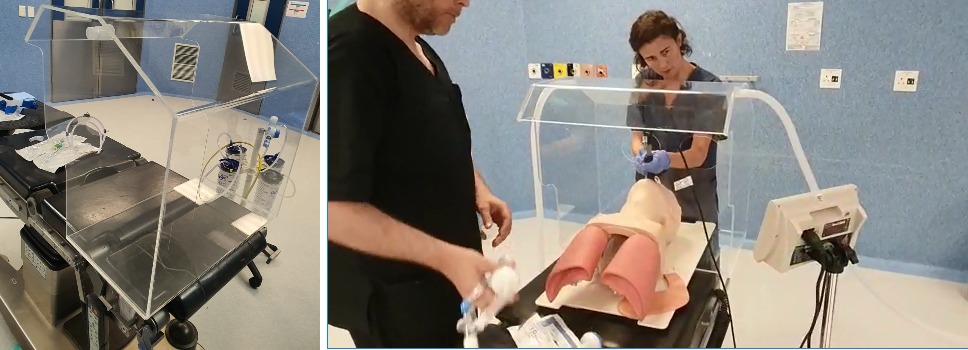
Alan McGillivray
Alan, an Electrical Engineering lecturer with expertise in electronics and projects, has, from the beginning, made it his goal to teach and educate students in an interesting, meaningful and exciting fashion - the way he always wanted to be taught.
Mechanical Engineering BTech student, Byron Blakey-Milner's optimised titanium mountain bike frame has made the top 38 entries in the world in the 2019 Permundus Challenge.
Reasons to be Proud - #R2bP: BTech Mechanical Engineering student Zaahid Imran, a team member in the Advanced Engineering Design Group in Mechanical Engineering, has been announced as one of the Top 5 Winners in the 2019 National RAPDASA Design Competition.
Reasons to be Proud - #R2bP: Stemming from a simple desire to curb water bills for the disadvantaged, Neo Mabunda and Zain Imran designed a water meter prototype that scooped two awards at the 2019 Sita ICT Public Service awards held in Durban last week.
Congratulations to Michelle Ngugi, M.Eng student, co-supervised by Tim Gibbon of Physics who had won the first prize for the best presentation of her paper at the African Laser Centre conference/workshop.
The Chair in Mechatronics, headed by Professor Igor Gorlach, facilitates engineering projects between the Nelson Mandela University's Mechatronics Department and Isuzu. Gorlach said it is important to expose Mechatronics students to the real industrial world, so that they can be better prepared for the final-year project.
On Friday, 24 August, the Mechatronics students assembled for an event that was unprecedented in the department – a Mechatronics Soccer Day. The goal of the event was to encourage team-work, and to form social connections between all members of the department.
Our Eco-Car Team were again crowned Champions of the 2018 Shell Eco-Marathon: South Africa (SEM: SA) in their category this last weekend in blisteringly hot conditions at the Zwartkops Raceway in Mid-Rand, Gauteng. This year’s event saw a record entry of 21 competitors from 4 different African countries, including International University entrants from Nigeria, Botswana and Namibia.
The overall aim is to enable disabled people in a wheelchair to pick up different objects like smartphones, wallets, etc. from the ground. The robotic arm should be mounted on the back of an electric wheelchair and be controlled with the joystick, which is already used for the driving.
Completed Masters Students, Graduated in 2016:
Johan Jordaan, 2016, The Design, Management and Testing of a Solar Vehicle's Energy Strategy, (MEng Mechatronics, Supervisor) Alexander Macfarlane, 2016, Modular Electric Automatic Guided Vehicle Suspension-Drive Unit, (MEng Mechatronics, Supervisor) Stuart Church, 2016, Energy Management System for the Diagnosis and Control of an Automatic Guided Vehicle (MEng Mechatronics, Supervisor)
The Southern Africa Association for the Advancement of Science (S2A3) Masters Medal (Bronze Medal) serves to commend outstanding South African research students graduating at the Masters level in a scientific discipline. These medals are awarded annually to one candidate selected by each South African university.
In 2016 Alexander Macfarlane received the Best Master Dissertation within the Faculty.
28 March 2017 saw the first South African Altair Technology Conference taking place at River Meadow Manor in Irene, Gauteng. When we started, we were not sure of what to expect with regard to attendance since was our first event. We would read with envy of Altair ATCx events in other countries with sizeable numbers. Little did we know! We had to finally close our registration page the week before, when we were reaching close to 80 registrations, our maximum for the venue!
Our one day event brought together engineers and designers from several industries to discuss the latest technology trends and developments around simulation-driven design and manufacturing in South Africa.
The Women in Engineering Leadership Association (WELA) held its annual launch on 24 February 2017 in the Auditorium in the New Engineering Building.
The South African satellite industry is taking yet another step forward as a player in the international arena with the launch of two South African built nanosatellites from Cape Canaveral in Florida within the next few days.
Martin Badenhorst’s presentation on his research into the Design, Optimization and Manufacture of a Carbon Composite Wheel for the NMMU Eco-Car has been accepted for presentation in the 2017 Altair Technical Conference: Europe in the main Technical Track aspect of the Conference – this is to be held from June 26th - 28th in Frankenthal, Germany.
Masters in Mechatronics graduate Goodness Onwuka (above) from Nigeria not only obtained his qualification cum laude, but also volunteered his time to mentor first-year students at the NMMU Student Academic Development Unit. Goodness is a lifetime scholar who would like to continue his qualification till doctoral level. His passion however lies in giving back to his community. Goodness would like to in future establish an NGO which specialises in distributing bicycles to students in rural communities who walk long distances to get to school.
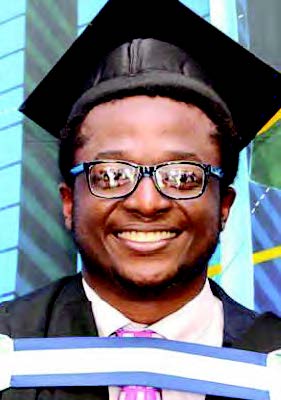
In 2010, while working as a process engi-neer in China, Heinrich contracted a bac-terial infection which resulted in an ab-scess pressing up against his spinal cord.
The pressure damaged his spinal cord and left him paralysed from the neck down, a C6 quadriplegic.
In 2013 Heinrich registered to study. “The first year was the hardest but my experi-ence at NMMU has been great. Young, old and across all races, Viking and I were accepted and able to mingle very well.”
Viking, his service dog has helped him achieved his Diploma. “He deserves to graduate with me, he was present in all my classes,” said Heinrich, 45.
Heinrich who is currently completing his BTech Industrial Engineering praises the Industrial department for all the support he receives from Dr Lourens and the team.
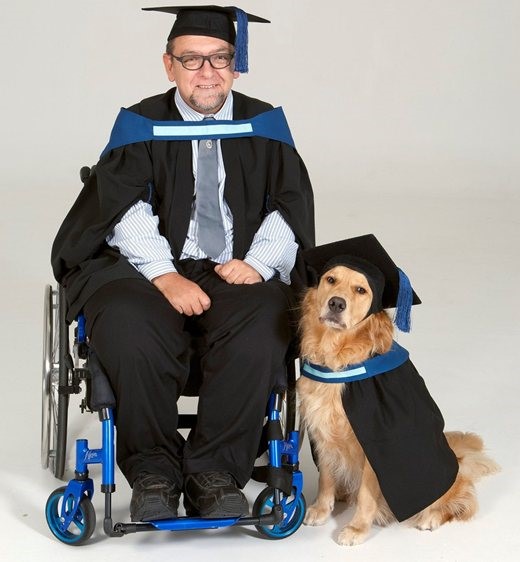
The fuel efficient Eco-Car which has been designed to travel nearly 300km on just one litre of fuel was recently on display at the Knysna Motor show.
“The objective of the Eco-Car project is to challenge students to manufacture and ultra lightweight car to maximise fuel efficiency and determine how far the vehicle can travel on a litre of fuel” said Mechanical Engineering Clive Hands.
A huge feather in the teams cap was an invitation to the flagship Shell Eco-Marathon event in London in June this year but Clive has said that the team has not been able to raise the R600 000 it would need to get there.
Should the team participate, they will compete in the prototype class, where a conventional petrol engine has been modified to accept a programmable fuel injec-tion unit to minimise fuel usage.
The Shell Eco Marathon is an established event world-wide with competitions in America, Asia, Europe and Africa.
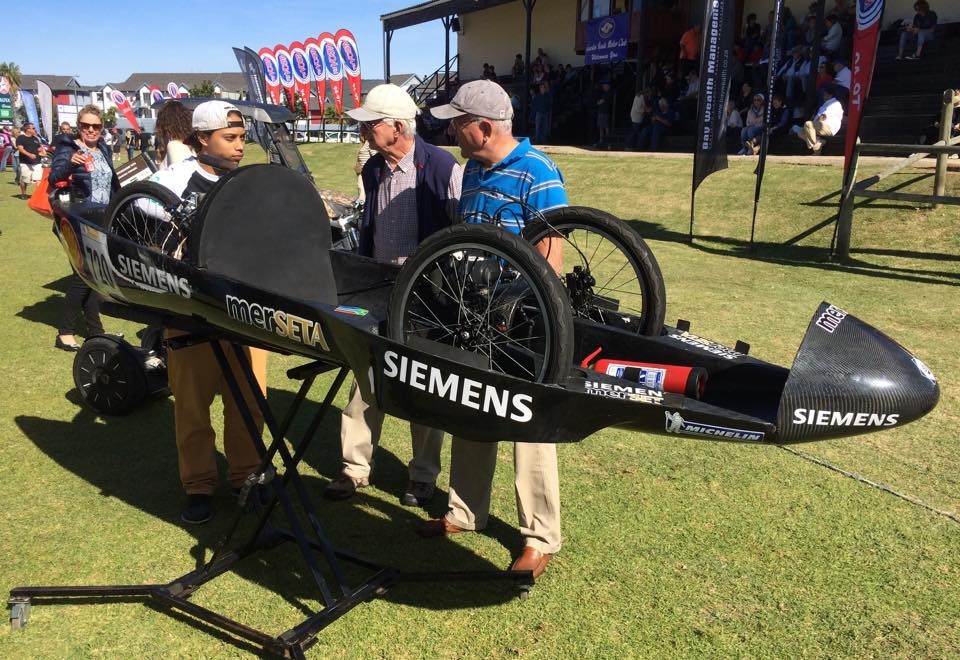
The School of Engineering would like to thank all those who exhibited at Open Day 2016 or availed their services and expertise. The event was a resounding success with almost 7000 visitors to the PE and George events.
At this year’s Open Day the Marketing Department recorded learners and parents from as far as Mtata, George, Plettenberg Bay, Humansdorp, Patensie, Pretoria, Vereeniging and East London to name but a few. The recorded numbers of school groups and individual walk-ins.
This event is not possible without the dedication, professionalism and knowledge of the exhibitors who annually go the extra mile in contributing to the overall success of the event.
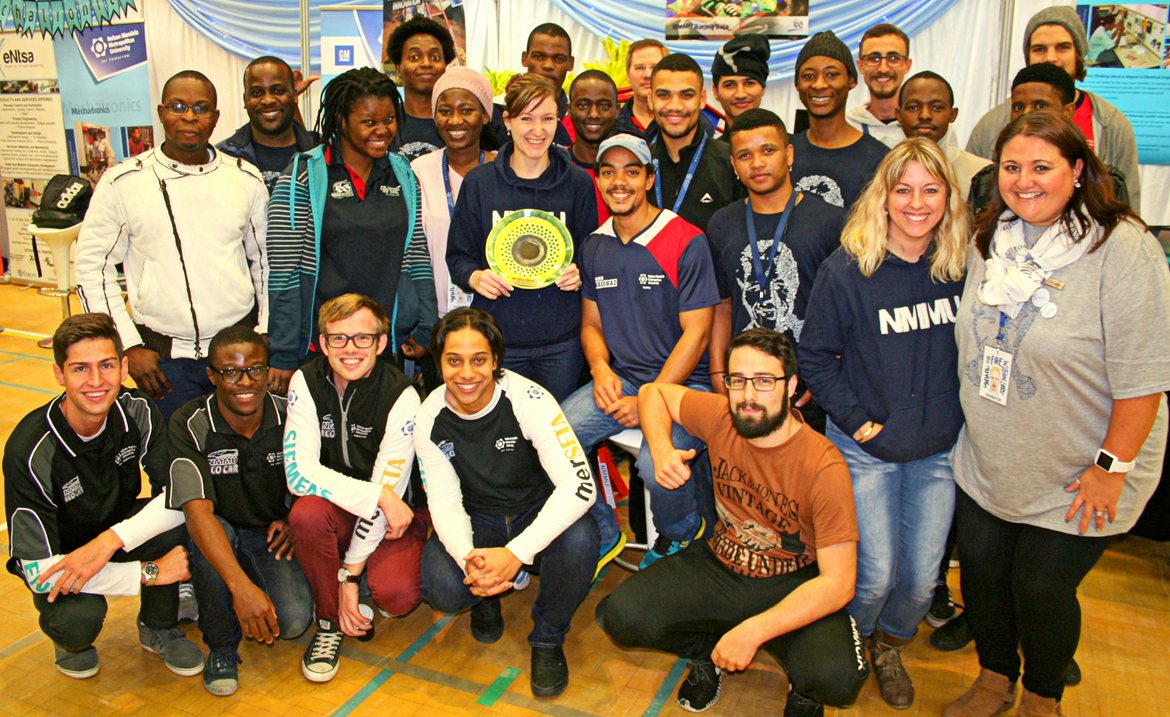
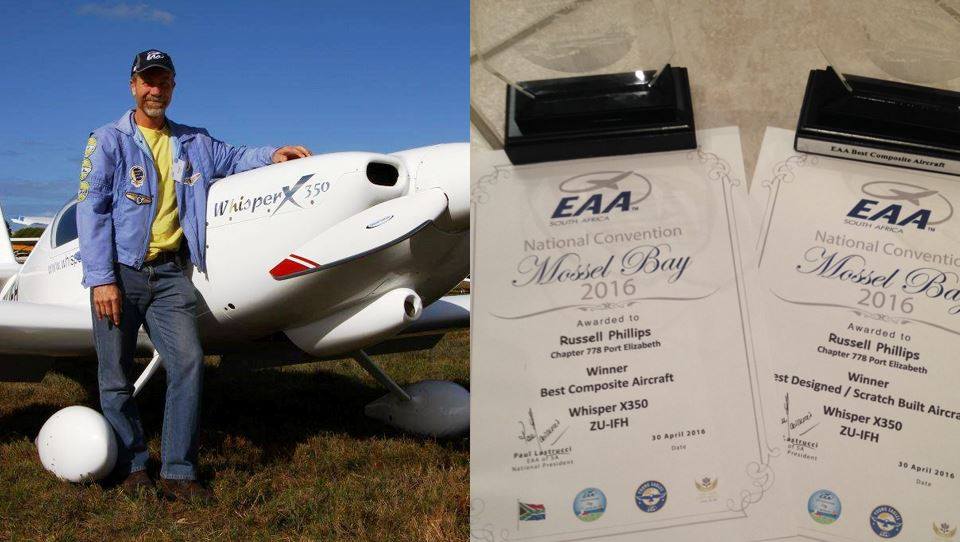
Our Prof who builds flying machines! Professor Russel Phillips, a Senior Lecturer in Mechanical Engineering at NMMU, received two awards at the annual Experimental Aircraft Association (EAA) Convention held last weekend in Mosselbay.
The Ford Motor Company of Southern Africa (FMCSA) donated on 18 May two high-tech turbodiesel engines to Nelson Mandela Metropolitan University’s Ford Engine Research Unit (FERU) – and, in a surprise announcement, also pledged to donate a Ford Ranger vehicle to the university.
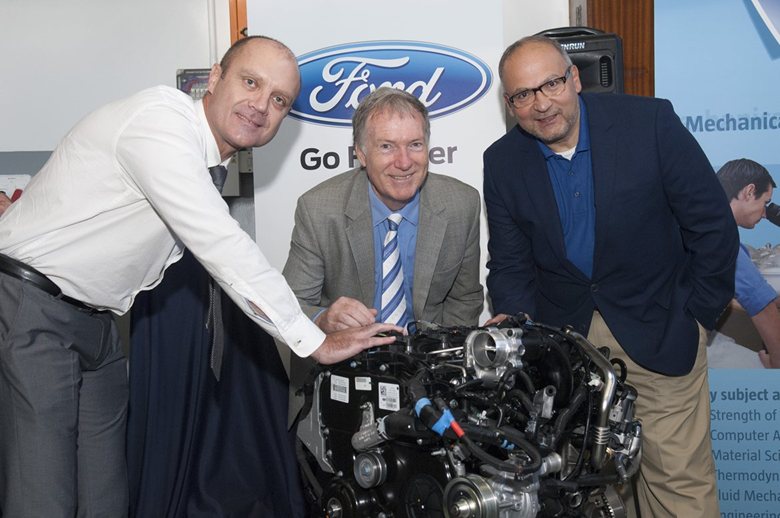
GENERAL Motors South Africa has renewed a partnership deal with Nelson Mandela Metropolitan University’s mechatronics department, aimed at ensuring continued skills development for motor manufacturing in Port Elizabeth.
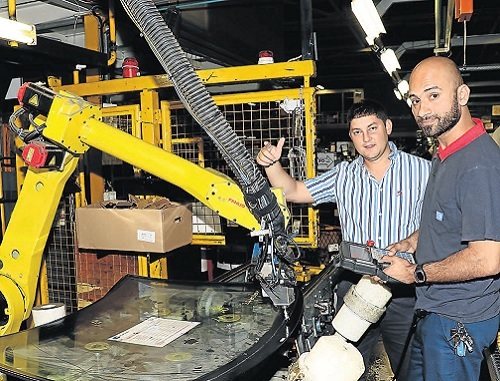
MEETING NEEDS: Mechatronics engineering graduate Nathan Kops, left, is now a full-time employee at GMSA. Inspecting one of the robotic systems in the Struandale assembly plant with him is automation technician Rais Salie.
Nelson Mandela Metropolitan University launched its brand new Bitumen Laboratory on Thursday , 21 April 2016. Students received hands-on experience of the latest equipment and testing methods, used in road construction and other fields.

The NMMU Eco—Car Team were thrilled to host VWSA MD, Thomas Schaefer and NMBBC, Kevin Hustler at the Eco-Car Lab on 16 May 2016.

The NMMU Science Students Association arranged a Science outing for the pupils from Masifunde High School from Walmer - we showed the Eco-Car off to the guys, and explained the hole design process to a very enthusiastic group of hopefully future engineers and scientists...

The Knysna motor show held on Sunday May 1, 2016 turned out to be a real blockbuster event and beating all expectations. The motor show was held in perfect weather with the most fantastic display of cars and motorcycles, complemented with new cars and trade related stalls. The display ranged from Vintage and Veteran cars, classic sports cars, super cars, classic and vintage motorcycles . A continuous stream of positive comments were received from participants as well as the public .
NMMU’s STEM (Science, Technology, Engineering and Maths) in Action’s Programme has been providing extra practical science sessions for Grade 10 to 12 learners from Northern Areas schools, to help learners make up for lost time.
The Degree of Doctor of Philosophy in Engineering (Mechanical): Dreyer Bernard
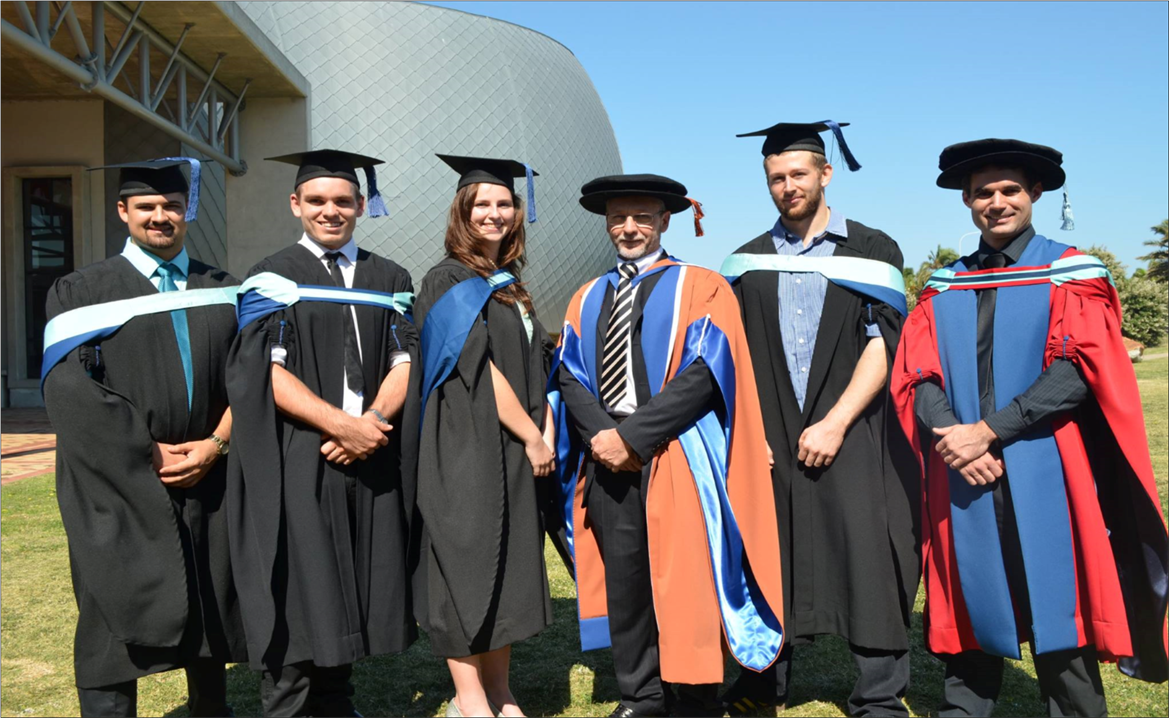
MEng Mechatronics graduates from left - Johan Jordaan; Alex Macfarlane (Cum Laude), Stuart Church (Cum Laude) and Prof Theo van Niekerk (Supervisor for all three students). Johan currently works at Volkswagen’s Product Engineering division; Alex is currently pursuing a PhD in Mechatronics whilst working at NMMU; Stuart is currently working at Bosch in Reutlingen, Germany. All three students were financially supported by the VWSA-DAAD International Chair in Automotive Engineering in pursuing their MEng Degrees.
The Faculty of Engineering, the Built Environment and Information Technology: School of Engineering, graduation ceremony took place Friday, 15 April 2016 at 09:30 in the Vodacom NMMU Indoor Sport Centre, South Campus, Summerstrand.
IN a major boost to the developing ocean economy in South Africa, merSETA is to provide R30 million over the next three years to NMMU to, among others, establish a Bachelor of Engineering Technology in Marine Engineering degree.
The Hot Rock™ system allows energy collected during the day to be stored for later conversion to electricity at a 1 to 5kW scale. The system comprises a parabolic trough, a rock bed and a heat engine. Solar thermal energy is collected using the trough and stored in the rock bed. The heat can then be converted to electricity using a heat engine.
Existing manufacturers of contact lenses for medical and cosmetic purposes currently use the average cornea profile of Caucasian users as a standard shape. However, the corneas of African people, particularly, are shaped differently to those of Caucasian people. Contact lenses which do not have the correct shape to match that of the user can cause ulceration of the membranes of the eye and also encourage bacterial infection. Prof Khaled Abou-El-Hossein, his team of postgraduates and collaborators at the University of KwaZulu-Natal, have been able to optimise the manufacturing process for contact lenses better suited for the African cornea profile, using specialised equipment.
NMMU took part in the inaugural “Innovation Bridge” hosted and arranged by the Department of Science and Technology in February 2015 in Pretoria. A ‘technology matchmaking showcase’, the event aimed at creating links between technology developers such as universities and science councils, and investors. The programme included technology exhibitions and demonstrations, policy dialogues and plenary discussions, training sessions and one-on-one meeting opportunities.
CONSTANT innovation supported by the Nelson Mandela Metropolitan University (NMMU) has ensured the success of Port Elizabeth-based Welfit Oddy – one of the only specialist steel tank container manufacturers in the world outside of China.
COMPANIES wanting to reduce the volume of liquid effluent safely could benefit from trials with concentrated sunlight being conducted in Nelson Mandela Bay.
A MECHANICAL Engineering workshop piled with blade samples gives testimony to the work being done at NMMU in developing new designs for small-size wind turbine blades.
OFF-GRID communities around South Africa and the rest of the continent can have their lives transformed in hours through street lighting, surveillance and Internet connectivity.
ONE of the biggest and most diverse fleets of working electric vehicles in South Africa provides a showcase of developments in the industry.
PERHAPS the biggest challenge facing renewable energy is energy storage when the wind is not blowing or the sun is not shining.
THE uYilo battery testing laboratory recently received certification from the SANAS (South African National Accreditation System).
AN OPPORTUNITY for the Eastern Cape to become the centre of production of automated guided vehicles (AGVs) for use in factories is an increasing possibility.
SCHOOL leavers wanting to enter the motor industry as engineers are obtaining world class education in the Eastern Cape.
CONSTANT innovation supported by Nelson Mandela Metropolitan University (NMMU) has ensured the success of Port Elizabeth-based Welfit Oddy – one of the only specialist steel tank container manufacturers in the world outside of China.
Off-grid communities in South Africa and Africa can have their lives transformed in hours through street lighting, surveillance and Internet connectivity.
NELSON Mandela Metropolitan University engineering students are hard-wired to solve problems.
The unlocking of Africa’s blue economy for sustainable ocean development offers Nelson Mandela Bay new growth areas, including that of education and training, writes Ed Richardson.
SKILLS required to ensure that Volkswagen South Africa (VWSA) continues to produce globally competitive cars are being honed and shaped in a collaborative partnership between the auto maker and NMMU.
Over 400 small engineering and manufacturing companies in the Eastern Cape have been helped to be more competitive by the eNtsa engineering technology station at Nelson Mandela Metropolitan University (NMMU).
NELSON Mandela Metropolitan University is positioning itself as an African centre for the training of marine engineers.
A PARTNERSHIP between business, government and Nelson Mandela Metropolitan University (NMMU) is helping to meet the shortage of certified welders in South Africa.
SOLID scientific study and innovation in Nelson Mandela Bay are behind a developed welding and repair process that is saving industry billions of rand.
ENTREPRENEURS, engineers, technical and marketing leaders from at least 140 Port Elizabeth-based companies are involved in a variety of projects run under the auspices of the Advanced Mechatronic Technology Centre at Nelson Mandela Metropolitan University (NMMU).
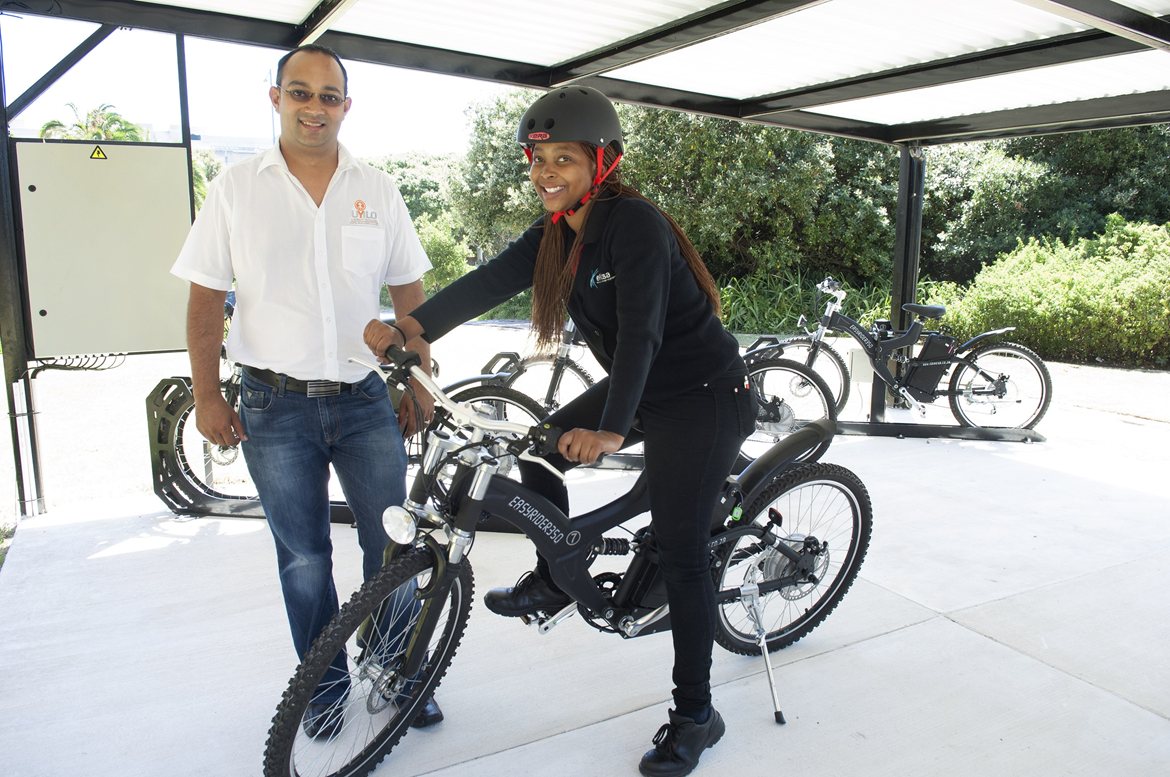 SOLAR-charged SHARED ELECTRIC BIKE FLEET.... Hoten Parmar (left), deputy director of the national uYilo eMobility Programme, based at Nelson Mandela Metropolitan University, gives mechatronics student intern (Unathi Mabi) a demonstration on how to use the new shared fleet of solar charged electric bikes (eBike) at NMMU.
SOLAR-charged SHARED ELECTRIC BIKE FLEET.... Hoten Parmar (left), deputy director of the national uYilo eMobility Programme, based at Nelson Mandela Metropolitan University, gives mechatronics student intern (Unathi Mabi) a demonstration on how to use the new shared fleet of solar charged electric bikes (eBike) at NMMU.
STUDENTS and staff at Nelson Mandela Metropolitan University can cut out the long walk between the university's North and South campuses, by hopping onto a shared solar-charged e-bike.
The South African Institute of Civil Engineering (SAICE), together with the Civil Engineering department at NMMU recently launched a "Student Chapter." The SAICE Student Chapter was established at NMMU to provide Civil Engineering students with the opportunity to become engaged with the world of Civil Engineering and to assist them with information relevant to their career path. Through their activities students will be able to interact with the Civil Engineering community thus making the transition from being a student to the work environment an easier one.
SAICE represents the interests of the Civil Engineering community in South Africa and currently has over 10000 members.
We look forward to seeing our young Civil Engineers students taking full advantage of these opportunities to develop their careers
Mechanical Engineering senior lecturer Dr Russell Phillips has turned a lifelong passion for both aviation and invention into a light aircraft. His Whisper X recently graced the cover of popular aviation magazine SA Flyer. This is the second aircraft to be designed and built by Russell, 49, who also has several noteworthy inventions in the renewable energy field, including the “twerly”, a “green” street light completely powered by wind and solar energy, which is being commercialised. He is also patenting a new type of wind turbine with segmented blades for more efficient wind harvesting.
Russell’s first aircraft was the Whisper motor glider in 2004. Both planes are sold as “kits” which flying enthusiasts can purchase to put together themselves. “Other people watch TV, I build things, fix things and invent things,” says Russell, who built most of the Whisper X in the garage of his Walmer home. “I’m an inventor during the day and after hours.”
Russell, who has been flying since he was in standard eight (Grade 10) built his first plane in 1984, when he was a second year student at the former Port Elizabeth Technikon. “I’ve owned 35 aeroplanes and built more than half of them. Some were kits, some were planes I restored.” It was only a matter of time before this self-proclaimed “aviation fanatic” built his own.
“The Whisper X is not unique or aero-dynamically different. It’s a combination of all the features that I like in planes that I’m familiar with.”The plane project has consumed most of his free time since 2008, but he has also been able to bring certain aspects into the classroom. “One of the subjects I teach is CAD (Computer-Aided Design) and I often bring in components [of the plane] to show students it’s not just a page in a book, but a real part in an aeroplane ... I don’t just teach, I do – and I believe this helps my teaching,” says Russell, who has won several NMMU teaching awards over the years. The plane is a composite (made from glass fibre-reinforced plastics) and students are able to use aspects of the structural design process as classroom examples. This exposure to composites helped in establishing the university’s first composites lab, which was used to produce the university’s unique solar car last year. “Airbus and Boeing are using more and more composite parts, with each new model that comes out. This will be the material of choice for high tech manufacturers in the future.”
The Whisper X is a similar design to the non-composite RV, which is the most popular “home built” in the world with over 8 000 flying worldwide, but Russell has designed his aircraft to outrun the slower RV, with a top speed of over 300km/h. Instead of the traditional “round gauges” in the cockpit to show speed and altitude, there is place for an iPad, which takes care of all the electronics at the touch of a screen. “There is less wiring, less complexity and less expense,” says Russell. “Most airliners today also have glass cockpits.”
Throughout the building process, the Whisper X was inspected and approved – but the first flight in his creation was still “terrifying”. “It’s a high performance, very fast aeroplane. If anything had gone wrong, it could have been fatal hence every precaution was taken”, says Russell, who is also a test pilot. NW
If you’ve noticed the variety and number of strange contraptions on the roof increasing then your eyesight is not deceiving you. The EBEIT Wind Energy Research Group (WERG) is hard at work with a number of experiments to do with harvesting of various renewable energies. The WERG group now has 4 interns working fulltime on the projects and big things are planned for 2013. Some of the main projects for 2013 are:
- Heating of air using parabolic collectors and transferring this heat to a bed of rocks insulated within a vacuum (It is hoped to be able to store heat for a few days and use as required. Great for those rainy days!)
- Refining our Solar Tracker (By tracking the sun with your solar panels you can gain up to 40% more energy per day)
- Developing a cost effective, rugged solar cooker (We hope to offer you a solar cooked boerewors roll before the end of the year and/or a solar heated cup of coffee!)
- Refining and commercializing our “green street light”. eNTsa is hard at work on this.
- Developing the NMMU patented variable geometry wind turbine blade which hopefully will show improved daily energy yields over current designs. Hold thumbs!
- Installation of wind turbine / solar panel power at a number of local schools.
Most of the projects are made possible by funding sourced through the Merseta / AIDC initiatives run by Karl du Preez and his dynamic team.
So if you’re at all interested in saving the planet (and your pocket) and have an interest in one or more of these exciting new green technologies pop in and pay us a visit at the Renewable Energy Lab in the E Block.
NMMU Racing has reached a key milestone in their “Green Technology” project by securing an entry into the prestigious 2013 “Formula Student Electric” competition.
The German Formula Student competition, held each year in the first week in August at the Hockenheim Formula One circuit, caters for both combustion and electric racing cars, and after the phenomenal success of their first car combustion car “DibaOne” in 2011, NMMU Racing has returned with an all-new Green Technology electric racing car, dubbed “DibaTwo GT”.
To successfully enter the competition, teams from around the world undergo a rigorous online registration process consisting of a quiz that challenges both the team’s technical knowledge, and understanding of competition rules. Over 100 teams competed for only 40 positions, and NMMU Racing made history once again, by being to first South African team to gain entry into this alternative-energy racing formula.
DibaTwo GT, is a giant leap forward from DibaOne, and includes brand new technologies such as 100KW, 450Nm Brushless-DC electric motor powered by Lithium Polymer batteries, targeting a 0-100Km/h acceleration of under 4.7seconds! Another new development is a unique aerodynamic package incorporating front and rear wings, and a Formula One style under-body diffuser to increase cornering down-force.
The highly-motivated NMMU Racing team, consisting of mechanical and electrical engineering students, along with business and marketing students, plans to begin testing of DibaTwo GT within the next two months
Dr Karl van der Merwe (left), Mr Jaco Snyders (Centre) and Mr Howard Theunissen (right) attended the Denel conference in Johannesburg to present research related to two new Denel projects, namely an unmanned aerial vehicle (UAV) and the development of a South African Regional Aircraft (SARA).
This initiative is to conduct research into the possible manufacturing of these products using the lean philosophy and principles.
Dr Mgangira holds a BSc degree in Civil Engineering, MSc in Engineering and earned his Doctorate at Ruhr-Universitat Bochum in Germany in 1992, with a focus in Geotechnical Engineering.
Dr Mgangira’s career has mostly been with academic and research institutions. For more than 11 years he lectured at the University of Malawi. During this time he held the positions of HOD Civil Engineering, Dean of Faculty of Engineering and Vice Principal at the Polytechnic, a constituent college of the University of Malawi. In 1997 he took up a senior lecturer position at the then PE Tecknikon in the Civil Engineering department and later got promoted to Principal Lecturer.
Since 2005 he has been working for the Council for Scientific and Industrial Research (CSIR). He is currently a Principal researcher within the Pavement Design and Construction research group of the Built Environment Unit. His areas of interest are Transport Geotechnics with a focus on geo-material characterisation and Engineering Education. He has published over 25 research papers including journal articles. As adjunct Professor he will collaborate in the delivery of NMMU civil engineering academic programmes and strengthen research activities within the Department
Prof Danie Hattingh (left) and Prof Hannalie Lombard (right) together with Dr Carlo van Zyl (center) who received his Doctorate in Philosophy in Mechanical Engineering
Dr Ian Wedderburn received his Doctorate in Philosophy in Mechanical Engineering. Ian’s thesis not only landed him a Doctorate in Philosophy degree but also a R1 million research contract with NMMU and Eskom.
The thesis, entitled “A Creep Sample retrieval technique and friction weld site repair procedure”, explores cost effective and efficient procedures to monitor creep loaded high temperature and pressure components in power stations.
The Technology Innovation Agency (TIA) in collaboration with Nelson Mandela Metropolitan University (NMMU) launched the Uyilo E-Mobility Programme, on the 13th of March 2013. This programme seeks to speed up the development of new technologies to create a sustainable infrastructure for the use of the electric vehicles through South Africa.
Awareness was created for the public with the programme launch that took place the 12th of March 2013. The pre-launch consisted of experiential stops at the Greenacres shopping mall, Govan Mbeki taxi rank, Sasol filling station in Summerstrand and at NMMU North Campus cafeteria. The public had the opportunity to view the cars and give their input regarding the new exciting programme. At the NMMU North campus, the student hype was incredible. As the university promotes an environment of technology transfer and innovation the programme was well received by the students, academics and researchers of the institution.
The Uyilo E-Mobility Programme hosted by NMMU and supported by several vehicle manufacturers, such as BMW and Nissan. Furthermore, NMMU provides a live testing facility which enables research activities to be undertaken, while private sector partners would provide market experience and TIA would provide funding.
Various power services are involved in this programme to encourage research and development of the technology and infrastructures to support both electric and hybrid vehicles. The electric vehicles will be powered by electricity whereas the hybrid vehicles will be powered by the use of two or more distinct power sources.
It is part of TIA’s mandate to promote research and technological innovation within the country and Higher Education Institutions. For this reason the NMMU technology station, eNtsa, was selected to host this project due to their ability to deliver projects on time, for their skills and expertise within the group reflected by past projects.
It is foreseen that the electric vehicle inevitable influence the face of the automotive industry and positively influence the investment within the South African economy and in turn challenge the perception of transportation.